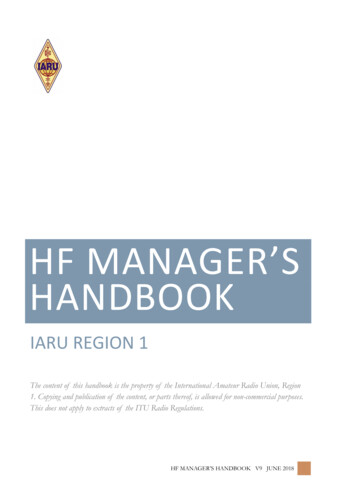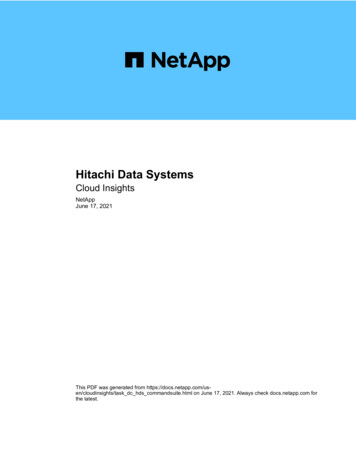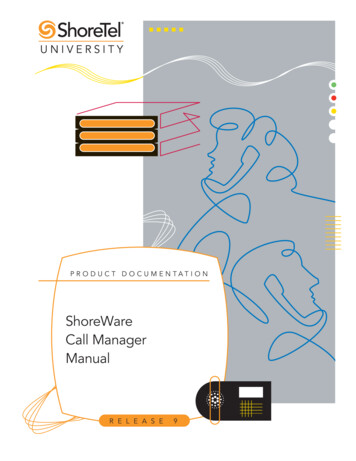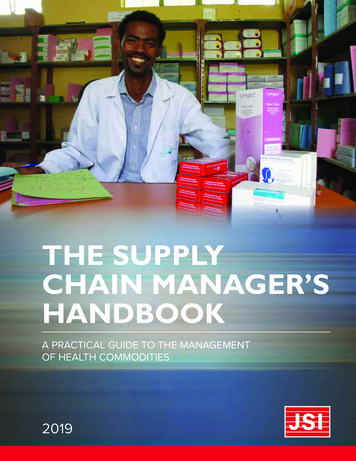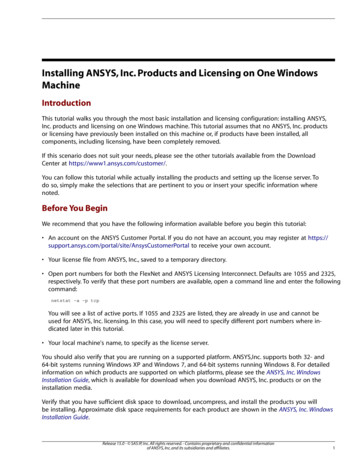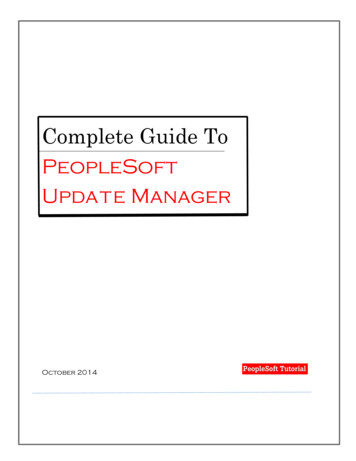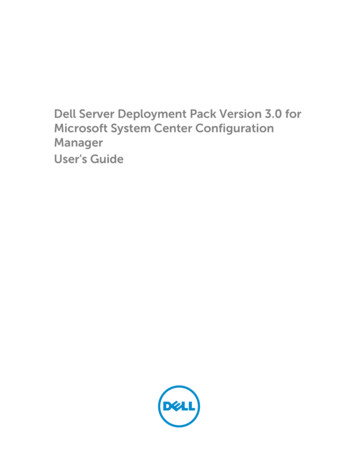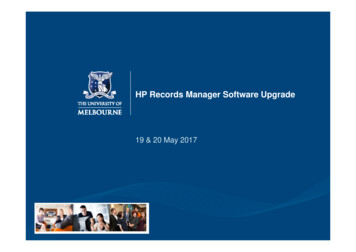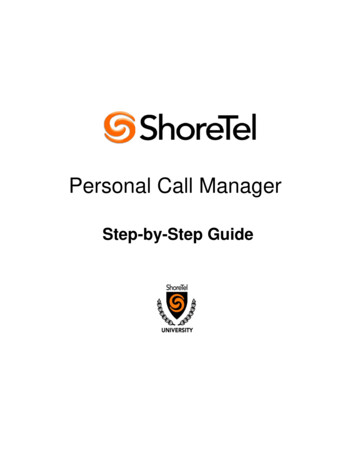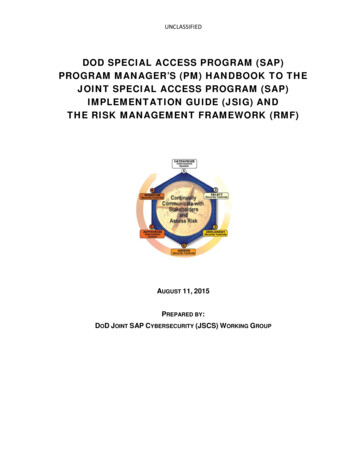
Transcription
UNCLASSIFIEDDOD SPECIAL ACCESS PROGRAM (SAP)PROGRAM MANAGER’S (PM) HANDBOOK TO THEJOINT SPECIAL ACCESS PROGRAM (SAP)IMPLEMENTATION GUIDE (JSIG) ANDTHE RISK MANAGEMENT FRAMEWORK (RMF)AUGUST 11, 2015PREPARED BY:DOD JOINT SAP CYBERSECURITY (JSCS) WORKING GROUP
UNCLASSIFIEDEXECUTIVE SUMMARYThis DoD Special Access Program (SAP) Program Manager’s (PM) Handbook to the Joint SpecialAccess Program (SAP) Implementation Guide (JSIG) and the Risk Management Framework (RMF)serves as a guide for Program Managers (PM), Program Directors (PD), Information System Owners(ISO), and Commanders 1 who are responsible for achieving an Authorization to Operate (ATO) for anInformation System (IS) within the DoD SAP Community. Obtaining an ATO is required under theFederal Information Security Management Act (FISMA) of 2002 and regulated by FederalGovernment and DoD SAP Community guidance that specifies the minimum security requirementsnecessary to protect Information Technology (IT) assets. Identifying security controls at thebeginning of the System Development Life Cycle (SDLC) and integrating throughout the SDLCoptimizes efficiency and cost-effectiveness. Through this new approach, PM/ISOs may avoidsurprises during the security assessment process and help to ensure timely achievement of ATOs.By following DoD Manual (DoDM) 5205.07 SAP Security Manual, JSIG, and the RMF methodology,the DoD SAP Community will implement technologically-sound systems with the necessarycapabilities to defend against threats, protect IT and information assets, and achieve its vital,national-security missions.Text boxes are provided throughout this document to emphasize key points importantto the role of Information System Owner (ISO) under RMF.The Joint SAP Cybersecurity Working Group (JSCS WG) is co-chaired by Jeffrey Spinnanger/OSD andRobert Nitzenberger/Navy CSD. The purpose of the JSCS WG is to provide organizations within theDoD SAP Community a forum to address all aspects of cybersecurity. JSCS WG functions andactivities related to RMF include: Promote DoD SAP Community coordination in methodologies for assessing and authorizingSAP information systems and related areas (e.g., documentation, tools, assessmentmethods, processes, etc.) to provide for consistency in methodologies, approaches,templates, and organization-defined values across the DoD SAP Community Develop, maintain, and periodically update the policies and procedures related to RMF toinclude, as needed, JSIG, RMF training, templates, and other supporting documentation Promote, review, and update training and awareness objectives, material, and availabilityfor all service, agency, and industry partners on cybersecurity, emphasizing insider threat,community best practices, and RMFCurrent organizations and primary POCs represented in the JSCS WG: AF – Michael Christmas; Amir Guy Army – Dr. Julie Mehan; Ruben Rios CSSWG/Industry – Matthew Lang; Doug Walls DARPA – Marshall Hawkins; Lisa Smith1The term Program Manager/Information System Owner (PM/ISO) will be used throughout this document to include Program Managers(PM), Program Directors (PD), Information System Owners (ISO), and Commanders. The ISO role is described in Section 3.1.11.April 2015UNCLASSIFIEDPage i
UNCLASSIFIED DSS- Jonathan CoferM DA- Shelly BriggsNavy- Tom KraftOSD- Jon HendersonSOCOM -Stephen SmithQuestions, comments, and feedback on documents related to the JSCS WG should be vettedthrough your working group representative. Contact Windy Benigno, JSCS WG facilitator, at 402315-0815 if you need your representative's contact information. Jeffrey Spinnanger and tionsorcomments:Jeffrey.p.spinnanger.civ@mail.mil; robert.nitzenberger@naw.mil.Approval:icuriDoD Special Access Prog afns Central OfficeRobert NitzenbergerDirector, Cybersecurity Directorate (CSD)DoNSAP DAA/AOApril2015UNCLASSIFIEDPage ii
UNCLASSIFIEDTABLE OF CONTENTSEXECUTIVE SUMMARY. I1INTRODUCTION . 11.1 Purpose and Scope . 21.2 Changes in Terminology . 31.3 Handbook Maintenance . 42RMF OVERVIEW. 53RMF PROCESS . 83.1 Roles and Responsibilities for the RMF Process . 93.1.1Agency/Element Head (Government) . 103.1.2Risk Executive (Function) Government. 103.1.3Chief Information Officer (CIO) (Government) . 113.1.4Chief Information Security Officer (CISO)/Senior Information Security Officer (SISO) . 113.1.5Authorizing Official (AO) (Government) . 113.1.6Delegated Authorizing Official (DAO) (Government) . 123.1.7Security Control Assessor (SCA). 123.1.8Common Control Provider (CCP) . 123.1.9Information Owner/Steward (Government) . 123.1.10 Mission/Business Owner (MBO) (Government) . 133.1.11 Information System Owner (ISO). 133.1.12 Information System Security Engineer (ISSE)/Information Assurance Systems Architect and Engineer(IASAE) . 133.1.13 Information System Security Manager (ISSM)/Information System Security Officer (ISSO) . 143.2 Steps in the RMF Process . 143.2.1RMF STEP 1—Categorize Information System (IS) . 143.2.2RMF STEP 2—Select Security Controls . 183.2.3RMF STEP 3—Implement Security Controls . 233.2.4RMF STEP 4—Assess Security Controls. 233.2.5RMF STEP 5—Authorize Information System . 243.2.6RMF STEP 6—Monitor Security Controls . 27REFERENCES . 30ACRONYMS . 32April 2015UNCLASSIFIEDPage iii
UNCLASSIFIEDLIST OF FIGURESFigure 1: The Six Steps of the RMF . 7Figure 2: DoD Acquisition, SDLC and RMF Processes . 9Figure 3: RMF Primary and Supporting Roles . 10Figure 4: C-I-A Triad and Definitions. 15Figure 5: Low-Moderate-High Impact Definitions . 16LIST OF TABLESTable 1: Changes in Terminology. 3Table 2: RMF Step 1 - Categorize IS . 15Table 3: Confidentiality Impact Level . 17Table 4: System Integrity and Availability Categorization Example . 17Table 5: RMF Step 2 - Select Security Controls. 19Table 6: Security Control Baseline Examples. 20Table 7: RMF Step 3 - Implement Security Controls. 23Table 8: RMF Step 4 - Assess Security Controls . 24Table 9: RMF Step 5 - Authorize Information System . 25Table 10: RMF Step 6 - Monitor Security Controls . 28April 2015UNCLASSIFIEDPage iv
UNCLASSIFIED1 INTRODUCTIONIn December 2013, the DoD Special Access Program Central Office (SAPCO) issued a mandaterequiring the DoD Special Access Program (SAP) Community to transition to the Risk ManagementFramework (RMF) and to use the Joint SAP Implementation Guide (JSIG), which provides essentialguidance to implementing the National Institute of Standards and Technology (NIST) SpecialPublication (SP) 800-53 security controls within the DoD SAP Community effective January 2014.Further, the DoDM 5205.07, SAP Security Manual, Volume 1, General Procedures (DRAFT), providespolicy, guidance, and standards for the application of RMF for the authorization of informationsystems (IS) within DoD SAPs and institutes the use of the JSIG as the replacement for the Joint AirForce – Army – Navy (JAFAN) 6/3 Manual, Protecting Special Access Program Information withinInformation Systems. The DoD and the Intelligence Community (IC) have adopted commonguidelines to streamline and build reciprocity into the assessment and authorization (formerlycertification and accreditation (C&A)) process under the RMF methodology.This DoD SAP PM Handbook provides a high-level summary of the RMF 2 and JSIG for programmanagers as well as other individuals involved in the RMF process.A Program Manager with a budget line for an information system is an InformationSystem Owner (ISO) under RMF. ISO responsibilities are included in this Handbook.One of the principal goals of the transformation initiative was to consider the entire mission andapply a balanced risk management process to reach an authorization decision. Informationassurance through implementation of the RMF provides organizations with a disciplined, structured,flexible, and repeatable process for managing risk related to the operation and use of informationsystems.To further facilitate information sharing within the Federal Government, DoD, and the IC; theCommittee on National Security Systems (CNSS) established standards applicable to DoD and the ICfor information system security categorization, security controls selection and organization-definedparameter values, and security controls assessment and monitoring for consistency and reciprocity.The DoD SAP Community is ensuring that its policies and procedures comply with the CNSSstandards (e.g., CNSS Instruction (CNSSI) 1253) allowing the DoD SAP Community to align with theIC’s approach to support reciprocity.The RMF process addresses risk holistically and emphasizes the development and use of commonstandards and processes. The Program Manager/Information System Owner (PM/ISO0 must nowaddress security and risk earlier in the System Development Life Cycle (SDLC), beginning duringconcept development and continuing throughout the entire life cycle from Initiation throughDisposal.The RMF is described in the National Institute of Standards and Technology (NIST) Special Publication (SP)800-37, Revision 1, Guide for Applying the Risk Management Framework to Federal Information Systems: ASecurity Life Cycle Approach. February 2010.2April 2015UNCLASSIFIEDPage 1
UNCLASSIFIEDIdentifying security controls at the beginning and integrating them throughout theentire SDLC is more efficient and cost-effective than addressing security controls at the endof the SDLC.This PM Handbook will explain the steps required to integrate security requirements throughout theSDLC and identify the key steps required for a system to obtain an Authorization to Operate (ATO).Preparing for and obtaining an ATO is required before deployment and operation of an IS. ThisHandbook will explain what to expect. Early up-front planning and integration of functional andsecurity specifications, cost, schedule, resources, skill sets, and deliverables help PM/ISOsproactively manage their programs and minimize the unexpected cost of tacking on securityrequirements late in the SDLC.Think Program Objective Memorandum (POM), budgeting for the right informationassurance (IA) equipment, personnel with the requisite skill set (e.g., information systemsecurity engineer (ISSE), network administrators, etc.), hardware, software, training;incorporating security controls with functional requirements during a system build, startingat system concept; and scheduling realistic timelines to include security assessments and tocorrect findings. IA has always been a part of owning an IS, RMF provides the framework toclearly identify and address the risk. This will likely require an increased IA budget, planaccordingly.Security risk management is an essential management function for protecting a DoD SAP element’sability to perform its mission, not just protect its information assets. Policy and legislation mandatespecific minimum security requirements to protect mission, information, and IT assets. Uniquemission and technology requirements may drive additional security requirements. Computersystems and networks are constantly under attack – putting missions at risk. Within the DoD SAPCommunity, balancing security of an IS with the need to accomplish the mission is a critical task.The goal of this transformative effort is to achieve greater interoperability and trust across the DoDSAP Community and with the IC.1.1 PURPOSE AND SCOPEThe purpose of this PM Handbook is to explain the RMF steps required to integrate securityrequirements throughout the SDLC and identify the key steps required for a system to obtain andmaintain an ATO. This Handbook is intended primarily for IS PMs. It provides the followinginformation about JSIG and the RMF: High-level process overviewThe relationship between SDLC and the RMFRoles and responsibilitiesInformation on the steps in the RMF processKey deliverablesApril 2015UNCLASSIFIEDPage 2
UNCLASSIFIED1.2 CHANGES IN TERMINOLOGYTable 1 provides a mapping between terminologies previously associated with informationassurance (IA) activities related to security certification and accreditation and new terminologyadopted under RMF.Table 1: Changes in TerminologyOld TermNew TermCertification and Accreditation (C&A) ProcessRisk Management Framework (RMF) ProcessCertificationAssessment or Security Control ntrolsProtection Level (PL)Accessibility (met through the following ine Accessibility OverlayBaseline CDS OverlayLevel of ConcernImpact LevelSecurity Requirements Traceability Matrix (SRTM)Security Controls Traceability Matrix (SCTM)System Security Authorization Agreement (SSAA) /System Security Plan (SSP)System Security Plan (SSP)Certification Test and Evaluation (CT&E)/ SecurityTest and Evaluation (ST&E) ReportSecurity Assessment Report (SAR)Designated Accrediting Authority (DAA)Authorizing Official (AO)Chief Information Assurance Officer (CIAO)Chief Information Security Officer (CISO)/ SeniorInformation Security Officer (SISO)Certifier, Certification Authority, Service CertifyingOrganization (SCO), Information System SecurityProfessional (ISSP)Security Control Assessor (SCA)DAA RepresentativeVaries depending on service/ agencyimplementation, e.g. certifierNo equivalentDelegated Authorizing Official (DAO)No equivalentRisk Executive (function) (REf)No equivalentCommon Control Provider (CCP)No equivalentOverlay (e.g. Accessibility, Cross Domain Solution(CDS), Privacy, Standalone, etc.)Information Assurance Manager (IAM)Information System Security Manager (ISSM)Information Assurance Officer (IAO)Information System Security Officer (ISSO)Program Manager/Program Director/CommanderInformation System Owner (ISO)*April 2015UNCLASSIFIEDPage 3
UNCLASSIFIEDOld TermNew TermInformation System Security Engineer (ISSE)ISSE/Information Assurance Systems Architect andEngineer (IASAE)Master SSP (MSSP)InformationAssuranceProcedures (IA SOP)Guest SystemExternal Information SystemStandardOperating*PM and ISO terms may be used interchangeably.The ISO is the official responsible for the overall procurement, development, integration,modification, or operation and maintenance of an information system. The ISO is responsible for allaspects of taking an information system from concept through authorization to operate (ATO) andthe continuous monitoring requirements that follow through system end-of-life. Success hinges onunderstanding the changing risk associated with your system and a sound working relationship withthe Authorizing Official (AO) and Security Control Assessor (SCA), as well as appointing an ISSM, ISSO,and potentially ISSE, with the right skill set to build/manage/monitor your system.1.3 HANDBOOK MAINTENANCEThe DoD Joint SAP Cybersecurity (JSCS) Working Group (WG) will review and evaluate this PMHandbook annually and update as appropriate.April 2015UNCLASSIFIEDPage 4
UNCLASSIFIED2 RMF OVERVIEWIn 2007, the IC Chief Information Officer (CIO), the DoD CIO, CNSS, and NIST formed the Joint TaskForce (JTF) Transformation Initiative Working Group. This interagency working group’s effort wasdesigned to produce a holistic, common process for security risk management, as documented inNIST Special Publications (SP).Some of the key changes highlighted in these publications include: The traditional compliance-focused C&A model, with periodic reaccreditations, has beenreplaced with a risk management approach with continuous monitoring of security controlsand periodic reauthorization.The RMF (including monitoring) has been adopted across the IC, DoD, and FederalGovernment civilian agencies.All Federal Government agencies use common security controls derived from NIST SP 80053, Recommended Security Controls for Federal Information Systems (Revision 3) or itsfollow-on, Security and Privacy Controls for Federal Information Systems and Organizations(Revision 4).The IC, DoD, and the DoD SAP Community use additional security-control guidance fromCNSSI 1253, Security Categorization and Control Selection for National Security Systems.NIST SP 800-53 and CNSSI 1253 are further augmented by the JSIG, which designates which NIST orCNSS publications shall be used by the DoD SAP Community. The JSIG also provides DoD SAPspecific values, identified as ‘organization-defined parameter values’ by NIST, for security controls,as appropriate to define at the DoD SAP Community level. Organization-defined parameter valuesnot identified at the DoD SAP Community level, will need to be defined at the organization orsystem level.The following documents have a key role in the assessment and authorization of SAP informationsystems: DODM 5205.07 SAP Security Manual :- Volume 1 (V1) General Procedures, Draft, Reference Enclosure 6, Cyber Security- Volume 2 (V2) Personnel Security, Draft- Volume 3 (V3) Physical Security, Draft- Volume 4 (V4) Marking, October 10, 2013NIST Publications:- NIST SP 800-53, Revision 3 3, Security and Privacy Controls for Federal InformationSystems and Organizations- NIST SP 800-53A, Guide for Assessing the Security Controls in Federal InformationSystems and Organizations, Building Effective Security Assessment Plans- NIST SP 800-37, Guide for Applying the Risk Management Framework to FederalInformation Systems3NIST SP 800-53, Revision 4, and CNSSI 1253, dated March 2014, have been issued; but as of the publication of this PM Handbook, theJSIG has not been updated to reflect NIST SP 800-53 Rev4 changes.April 2015UNCLASSIFIEDPage 5
UNCLASSIFIEDNIST SP 800-39, Managing Information Security Risk: Organization, Mission, andInformation System View- NIST SP 800-30, Guide for Conducting Risk AssessmentsCNSSI 1253, Security Categorization and Control Selection for National Security Systems,March 2012Joint SAP Implementation Guide (JSIG), October 9, 2013 for NIST SP 800-53, Revision 3- Additional NIST publications provide guidance on various aspects of cybersecurity and the RMFmethodology including, but not limited to: NIST SP 800-59, Guideline for Identifying an Information System as a National SecuritySystemNIST SP 800-60 Volume I, Guide for Mapping Types of Information and Information Systemsto Security CategoriesNIST SP 800-60 Volume II, Appendices to Guide for Mapping Types of Information andInformation Systems to Security CategoriesNIST SP 800-64, Revision 2, Security Considerations in the System Development Life CycleNIST SP 800-137, Information Security Continuous Monitoring for Federal informationSystems and OrganizationsNISTIR 7298, Glossary of Key Information Security TermsIn the near future, the DoD SAP Community will transition from implementing securitycontrols based on NIST SP 800-53 Revision 3 to implementing controls in Revision 4. Ensureyour personnel and individuals you interact with during joint authorization and reciprocityuse documents that map to each other. Do not transition to NIST SP 800-53 Rev4 untilauthorized by the AO. Documents align as follows:NIST SP 800-53 Rev3NIST SP 800-53 Rev4CNSSI 1253, March 2012CNSSI 1253, March 2014JSIG, October 9, 2013JSIG, TBD 2015JSIG, October 9, 2013 Errata Sheet, March 2, 2015April 2015UNCLASSIFIEDPage 6
UNCLASSIFIEDThe diagram in Figure 1 4 below illustrates the six steps of the RMF as applied in the DoD SAP processfor information system security and risk management, also known as the assessment andauthorization process. Information system security is defined as the secure design, implementation,configuration, operation, and continuous monitoring of security controls. System security alsodepends on ongoing risk management, which requires active situational awareness of external andinternal threats and attacks, as well as a process for identifying issues, assessing impact, and takingaction.Figure 1: The Six Steps of the RMF4Note: Figure 1 maps the RMF Steps to publications that provide additional details about each phase of the process.April 2015UNCLASSIFIEDPage 7
UNCLASSIFIED3 RMF PROCESSThis section describes the RMF’s six (6) Steps and the security authorization artifacts (section3.2.5.1), which the Authorizing Official (AO) 5 uses to make an informed risk–based decision whetherto grant an ATO for an IS.NIST SP 800-37 is designed to provide consistent guidelines for applying the RMF to Federal 6 ITsystems. The 6 steps of the RMF process are: Step 1—Categorize Information SystemStep 2—Select Security ControlsStep 3—Implement Security ControlsStep 4—Assess Security ControlsStep 5—Authorize Information SystemStep 6—Monitor Security ControlsThe output of the RMF process includes an understanding of the risk associated with the system andthe security authorization artifacts, also known as the Body of Evidence (BoE), submitted as part ofthe Security Authorization Package for the IS. The AO will use the Security Authorization Package todetermine whether deployment of the IS presents or continues to present an acceptable level of riskto organizational operations, organizational assets, individuals, other organizations, and the Nation.Security artifacts include, but are not limited to: System Security Plan (SSP), Risk Assessment Report(RAR), Information Security Continuous Monitoring (ISCM) Plan (commonly referred to as theContinuous Monitoring (ConMon) Plan), Security Assessment Report (SAR), and Plan of Action andMilestones (POA&M). Additional information on the security authorization artifacts is given inSection 3.5.Although the PM/ISO will likely delegate the development and update of documentsin the Security Authorization Package, the PM/ISO will sign off on the Security AuthorizationPackage before forwarding it to the SCA/AO, indicating that the documentation accurately reflectsthe configuration and security state of the information system and the environment in which itoperates.56Previously referred to as the “Designated Accrediting Authority (DAA).”The term ‘Federal IT systems’ includes all Federal civilian agencies, DoD and the IC.April 2015UNCLASSIFIEDPage 8
UNCLASSIFIEDThe RMF emphasizes the need to consider security throughout the system life cycle. As illustratedin Figure 2 below, the RMF, the SDLC, and Acquisition processes are closely aligned.Figure 2: DoD Acquisition, SDLC and RMF Processes3.1 ROLES AND RESPONSIBILITIES FOR THE RMF PROCESSFor a PM/ISO to successfully navigate an IS through the risk management process and obtain anATO, the following participants/stakeholders are critical. In addition to the traditional design anddevelopment team, resources may include participants/stakeholders described in the followingsubsections. Roles and responsibilities are also defined in DoDM 5205.07 and the JSIG. As indicatedin the JSIG, not all roles are required for all systems, e.g. there may not be a Chief InformationSecurity Officer (CISO), Delegated AO (DAO), or Information System Security Engineer (ISSE) andsome roles may collapse with AO approval.Primary and supporting roles for each step in the RMF are depicted in Figure 3. In some situations arole may float from supporting to primary or vice versa depending on the system, environment, andApril 2015UNCLASSIFIEDPage 9
UNCLASSIFIEDmission, e.g. not all systems will have an ISSE assigned. Roles and responsibilities are further definedin the remainder of this section.Figure 3: RMF Primary and Supporting Roles3.1.1 AGENCY/ELEMENT HEAD (G OVERNMENT)Each DoD SAP Element Head bears ultimate responsibility for mission accomplishment andexecution of business functions, and hence for adequately mitigating risks to the element, itsindividuals, and the Nation. The Element Head defines priorities to ensure collaboration andinformation-sharing sufficient to ensure both element and DoD SAP Community-wide missionaccomplishment As stated in NIST SP 800-37, the Element Heads are responsible for ensuring that:(i) information security management processes are integrated with strategic and operationalplanning processes; (ii) senior officials within the organization provide information security for theinformation and information systems that support the operations and assets under their control;and (iii) the organization has trained personnel sufficient to assist in complying with the informationsecurity requirements in related legislation, policies, directives, instructions, standards, andguidelines.3.1.2 RISK EXECUTIVE (FUNCTION ) GOVERNMENTThe Risk Executive function (REf) may be fulfilled by an individual, a group, or an assigned functionwithin an organization. The REf directly supports the Authorizing Official (AO) and ensures: (i) thatrisk-related considerations for individual information systems, to include authorization decisions,are viewed from an organization-wide perspective (with regard to the overall strategic goals andobjectives of the organization in carrying out its core missions and business functions) and (ii) thatApril 2015UNCLASSIFIEDPage 10
UNCLASSIFIEDmanaging information-system-related security risks is consistent across the organization, reflectsorganizational risk tolerance, and is considered along with other types of risks in order to ensuremission/business success.3.1.3 CHIEF INFORMATION OFFICER (CIO) (GOVERNMENT)The CIO 7, along with the Element Head and other senior officials, ensures that information systemsare acquired and information resources are managed in a manner consistent with laws, ExecutiveOrders, directives, policies, regulations, as well as priorities established by the Element Head. TheCIO develops, maintains, and ensures the implementation of sound, secure, integrated, ISarchitectures and promotes the effective, efficient design, development, and operations of all majorinformation and resource management processes.3.1.4 CHIEF INFORMATION SECURITY OFFICER (CISO)/SENIOR INFORMATION SECURITY O
Aug 11, 2015 · UNCLASSIFIED April 2015 UNCLASSIFIED Page i EXECUTIVE SUMMARY This DoD Special Access Program (SAP) Program Manager’s (PM) Handbook to the Joint Special Access Program (SAP) Implementation Guide (JSIG) and the Risk Management Framework (RMF) serves as a guide for Pro
